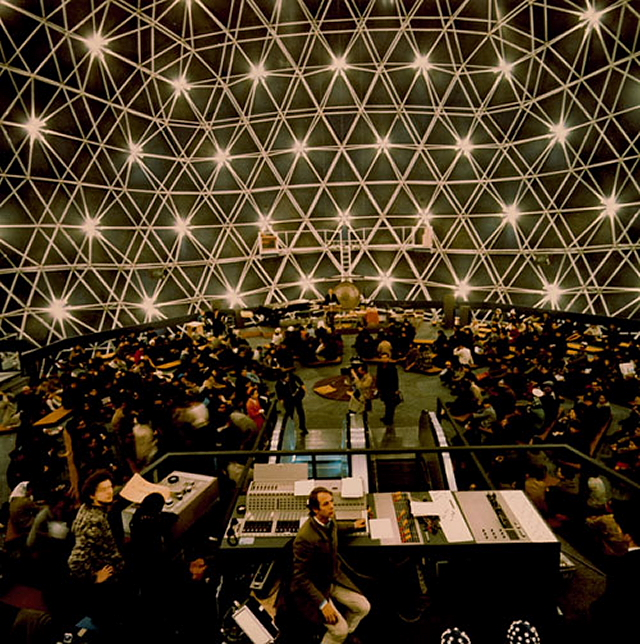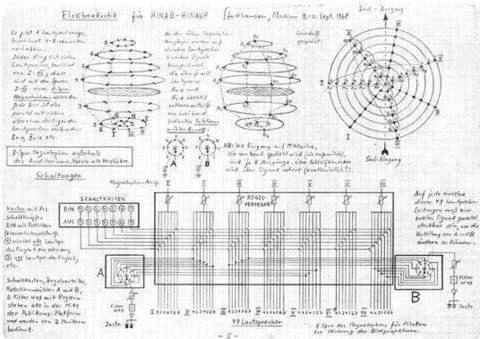
Bitcoin is undoubtedly a magnificent crypto-asset, but how does it stack up to peak experiences in lived life, in its overall value?
Does the moral choice to enjoy possession of bitcoin survive consideration of the alternative possibility of creating a spherical concert hall, for example?
Though I’m very long on bitcoin (which is already at c. $50k), and therefore tempted to hoard my stash till my dying days, I am also long on the value of human experience, which I think of as the essence of the value of our miraculous existence.
This presents a specific practical question: what should I do, hoard my bitcoin or turn it into magical experiences in a spherical concert hall?
In this post I set out to decide. I’m assuming you know all about Bitcoin, so I’ll focus mainly on describing what a spherical concert hall is, on the basis of the only example that yet existed, before comparing the relative value of owning a Bitcoin vs such a concert hall.
Part 1: The short, glorious history of the Kugelauditorium
The so-called Kugelauditorium was a spherical concert hall built by architect Fritz Bornemann after a musical concept from electronic composer Karlheinz Stockhausen for the West German pavilion at the astonishing Osaka 1970 world fair. It charmed half a million people in its brief existence, but has not been re-attempted since.
Design of the structure

The basic idea of the ‘Kugelauditorium’ was, in Stockhausen’s own words, to create “a spherical chamber, with a platform, transparent to both light and sound, hung for the listeners. They could hear music coming from above, from below and from all directions.”

3D sound arrangements

Concretely, this was accomplished with a huge spherical Buckminster Fuller Dome, in which a raised platform, transparent to sound, sat up to 500 people roughly in the middle of the sphere. A total of fifty sets of loudspeakers arranged in 7 rings allowed sound to be played from any point in 3-Dimensional space. You can see how it was wired above.

Stockhausen is pictured above standing at the sound desk, where he could control the position and trajectories of up to ten individual sound channels, using either a ten-channel rotation mill made to Stockhausen’s spec or instead a spherical controller designed by Fritz Winckel of the Electronic Music Studio at the Technical University of Berlin .
Manipulating the sounds
The Kugelauditorium was something between a concert hall and a new musical instrument, and enabled the invention of a new, completely 3-Dimensional form of audiovisual music, one in which the content of the musical sounds and their spatial paths, accompanied by light trails, were composed together, to produce dynamic structured murmurations of enshrouding audiovisual sound.

Audi-visual music
Though I haven’t been able to learn so much about the visual component of the Kugelaudtorium, it’s clear that the visual environment was as much a part of the music as the auditory one. Below you can see the auditorium in a state of darkness. Just imagine all the different motifs of lights-sounds flying around the interior. Just imagine how much easier and better this could be done with today’s electronics and software!

A note on audiovisual interactions in perception
Work over more than a century in multisensory integration in humans has detailed the many ways in which sight and sound interact, and their different specialities for perception. For example, sound has much high temporal resolution than vision. Three bleeps played simultaneously with two flashes of light can lead to a visual experience of three flashes, as sound dominates vision in matters of time. Spatially, though, vision is more precise than hearing, so when you see a flash in space played at the same time as a bleep, the perceived position of the bleep will be pulled towards the sound in experience.
This suggests that an experience of location in space much more precise than the spatial resolution of human sound perception can be accomplished by addition of correlated light- an extraordinary possibility.
Compositions in spherical music
Stockhausen, Zimmerman and Blacher among others composed extraordinary new compositions for this unique space.
Sadly it is of course impossible to re-experience this music till we build another such space.
What happened to the Kugelauditorium?
Vastly ambitious for 1970, Stockhausen’s Kugelauditorium rocked the Osaka world fair, and enjoyed more than half a million visitors.
The project was however beset by technical, social and financial issues, and never made it back to Germany, where it had been constructed; instead, it fell into ruin, and in the fifty years since its heyday no further attempts have been made to create such a spherical concert hall.
Overall, it seems to me to be a first attempt at a potentially outstanding genre of musical experience. Is there any town or festival in the world that wouldn’t appreciate the play of a contemporary version of this instrument? Is there a composer who wouldn’t light up at the chance of creating for this medium (assuming the right tools). Is there a festival goer who wouldn’t love to chill to whatever, say, Nils Frahm or Jean-Michel Jarre could cook up? It seems unlikely.
It’s thought provoking indeed to look at some of Jarre’s audiovisual work, for example this from Notre-Dame cathedral:
Part 2: Financial vs experiential capital
There’s a serious question that all of us implicitly answer through the living of our lives, that is much more general than the one I’m posing here, which is roughly: to what extent should we value experiences over things? Or alternatively, what is the relative value of financial vs experiential capital?
There are many ways we can come at this question, and I’d be very interested to hear other frameworks. But given the (perhaps illegitimately binary) choice: which would you rather possess, some bitcoin or a spherical concert hall, I come at it by thinking of which of how the two rank in terms of their uniqueness, perceptibility and generosity.
Implicitly, I’m saying that we should optimise in this world for these three elements.
a) Scarcity of bitcoin vs spherical concert halls:
There are 21 million Bitcoin VS zero spherical concert halls.
On this front, it’s clear the concert hall wins. There have been zero examples of this form of Being in the last fifty years, whereas 18 million bitcoin have already been mined, even if no more than 21 million ever will.
Overall, though, the world is awash with Bitcoin but entirely lacks any spherical concert halls.
So the spherical concert hall clearly wins here.
b) Perceptibility of bitcoin vs spherical concert halls:
Perceptibility is important, because all consciousness derives from perception (cf Merleau-Ponty).
Bitcoin actually put a heavy weight on perception – albeit indirectly. So bitcoin owners ten frequently to Google the price of their asset, and look yearningly at the prices from half a decade ago etc. These experiences are of low quality, linking mainly to avarice, and not challenging or inspiring the perceptual systems.
The Kugelauditorium, by contrast, is perhaps the greatest object of perception invented in the 20th century: challenging, bending and stimulating the senses in astonishing, transformational ways.
Again, the spherical concert hall wins.
c) Generosity of bitcoin vs spherical concert halls:
While Bitcoin can in principle be given away, its sky-rocketing value disincentivizes spending it, let alone donating it. Meanwhile, sadly, your bitcoins make your friends unhappy as they all wish they had this chancey asset to their person instead of you. Their lives are diminished by your luck.
Bitcoin is, then, a zero sum game, at the individual level. If you own a bitcoin, that means that somebody else doesn’t. It is at best non-generous, and at worst an act of avarice, to actually own one.
By contrast, everyone will obviously want to hang out in your Kugelauditorium. It is by nature a shared social space that purveys to its occupants riches from the outer frontiers of what is experientially possible in the human mind. It is inherently a generous concept.
One might also consider electricity consumption. The total bitcoin network usage is as much as 121 terra-watt-hours. If we divide this equally between the c. 18 million bitcoin in existence, each existent bitcoin consumes roughly as much energy as a house in the US (7 MWhrs).
This is quite ungenerous to a struggling planet. But the energy consumption of future Kugelauditoria may be similar, so on this sub-point it is a draw.
But overall Kugelauditoria are inherently much more generous.
Conclusion
Looked at through these lenses, it’s better to own a spherical concert hall than Bitcoin. I have therefore liquidated by Bitcoin holdings to fund the creation of a second Kugelauditorium.
The task of creating the second Kugelauditorium with contemporary materials, electronics and software is spine-tinglingly laden with possibility. It should be orders of magnitude easier, cheaper and more elaborable building a spherical concert hall now than it was 50 years ago. I expect that we may be able to create something relatively astonishing.
Since I have no idea how to build anything, I have created this form for anyone who wishes to help.
The main areas where we can anticipate the need for help to begin with are:
- Design / construction of geodesic dome
- Rigging of speakers and lights
- Electronics for pushing the light-sound around the sphere
- Software to enable speedy creation and sharing of audiovisual compositions
- AI programs for translating existing repertory of music into audiovisual 3-D sound.
Once again, do please sign up to help here.
We have a preliminary spot in Burgundy for building the first Kugelauditorium; the intent is to open-source the designs and findings in the hope that every town around the world, or at least one other group, will eventually build one for themselves.

Leave a Reply